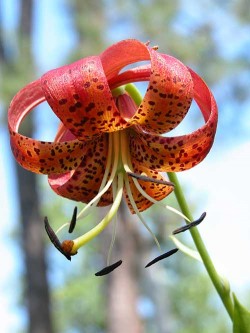
By Ken Moore
Flora Columnist
This Friday is Endangered Species Day, when America celebrates our nation’s commitment to protecting wildlife on the brink of extinction (EndangeredSpeciesDay.org).
The N.C. Botanical Garden has scheduled three hour-long Endangered Species Day tours – 11 a.m., noon and 1p.m. – this Friday, beginning at the Gathering Circle in front of the Totten Center. No fee or registration is required. Just show up. Johnny Randall, assistant director for conservation and natural areas; Mike Kunz, conservation ecologist, and Andy Walker, conservation botanist will be available to show you endangered and rare species and they will describe the ways the Botanical Garden is involved with rare-plant research and protection and natural-areas management.
For example, staff and volunteers are propagating plants of endangered harperella, Ptilimnium nodosum, and planting them (reintroduction) back on their historical location on the Deep River in Chatham County.
Similarly, staff and volunteers are augmenting small populations of sandhills lily, Lilium pyrophilum, a recently discovered rarity of the sandhills.
Endangered species smooth coneflower, Echinacea laevigata, is being reintroduced to appropriate habitats within its historic range.
All of the above plant species are being propagated from plants of the original habitats to help insure the continuation of the natural diversity of the sites.
In cooperation with the N.C. Department of Transportation, a population of endangered roughleaf loosestrife, Lysimachia asperulifolia, was translocated from highway construction to a DOT conservation area.
Botanical Garden staff also manages approximately 900 acres of natural areas, many of which contain rare species, where eradication of invasive species and use of prescribed fires are some of the management tools used to protect natural-plant and animal communities.
In 1970, the Botanical Garden initiated the nationally honored “Conservation through Propagation†program to provide an alternative to wild-collecting. In 1979, it played a strategic role in establishing the N.C. Plant Conservation Program in the N.C. Department of Agriculture and Consumer Services. In 1984, it was a founding member of the national Center for Plant Conservation. Other important organizations and agencies in collaboration with the Garden include The Nature Conservancy, NatureServe, N.C. Natural Heritage Program, U.S. Fish and Wildlife Service, U.S. Forest Service, National Park Service and Botanical Gardens Conservation International.
The Endangered Species Day website describes 10 things to do at home to protect endangered species, including planting native plants and minimizing (best to eliminate) herbicides and pesticides.
I suggest we include another significant way to protect endangered species, and I include us humans in this category. If you did not participate in last Saturday’s “Great Unleasing†at Carrboro’s Century Center, you should become active with Transition Carrboro-Chapel Hill (transitioncch.org). Sign up to become involved with this group, the local body of a worldwide action group, committed to changing the way we work and live to meet environmental and economic challenges in positive, Earth-friendly practices. Protecting endangered species begins with our own manner of living.
And celebrate the nature of our community by taking a walk at Mason Farm, where the Botanical Garden’s fire ecology management has resulted in acres of tall white beardtongue, Penstemon digitalis, in flower now!






